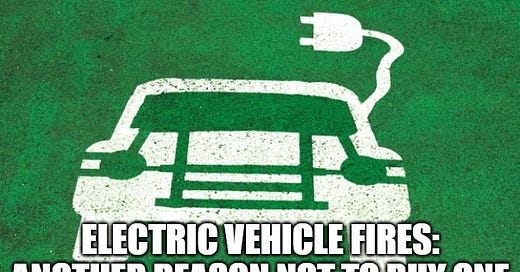This American was on a Zoom Town Hall with my state senator and two state representatives Wednesday night when Senator Jeff Wilson mentioned the dilemma firefighters find themselves in when they are called to put out an Electric Vehicle fire. Wilson, who has owned an EV for five years and loves it, told the audience that it takes 130,000 gallons of water to extinguish an EV fire, more than most fire trucks can carry. I have been studying the “EV Movement” for a year and a half and had not heard that EV fires are not the same as house fires or gas-powered car fires, so I researched the topic. I wonder if I will ever fly again now that I know that passengers are carrying lithium-ion batteries onto planes in their cellphones, laptop computers and other devices.
LITHIUM-ION BATTERIES: A FIREFIGHTER’S WORST NIGHTMARE
The rechargeable batteries that power e-bikes, scooters and electric cars pose a dangerous new threat to firefighters and homeowners. They burn hotter and longer than almost all other types of fires, and most fire departments are unprepared to tackle them.
Lithium-ion battery packs are made up of a group of cells inside a battery compartment and contain a flammable liquid electrolyte. The more electricity needed, the higher the number of cells. EV and plug-in hybrid vehicles, for example, have about 1,000 times more cells than an e-bike. With the increased number of cells and higher energy batteries comes a greater risk during failure.
Last June, four people were killed and two others seriously injured after a lithium-ion battery malfunctioned and sparked a fire in a first-floor e-bike shop in New York. Fire officials say the blaze quickly spread to apartments above the shop. And this fire was not an isolated incident. Fires caused by rechargeable batteries, including lithium-ion batteries, have been increasing steadily in large cities like New York and San Francisco. Since 2019, fire departments in these two cities say they've responded to at least 669 such fires combined, causing 219 injuries. Lithium-ion batteries also cause significant property damage.
And pilots and flight attendants are worried about “lithium battery incidents” on airplanes. If DEI-hired pilots don’t scare Americans away from flying, this might. The FAA verifies the number of lithium-ion battery fires jumped more than 42% in the last five years. A CBS News analysis of the FAA's data found that since 2021 there's been at least one lithium battery incident on a passenger plane somewhere in the US, on average, once every week.
UNPREDICTABLE COMBUSTION
Part of the challenge for firefighters is that these batteries can be unpredictable. If there is a charging failure, a puncture or an impact from a crash, the batteries can ignite and lead to a phenomenon known as "thermal runaway."
"It's a chemical reaction where the heat from one cell of the battery ignites the next cell," said Andrew Klock, senior manager of training & education at the National Fire Protection Association. "If you think about it, it's like a bunch of matchsticks and if you light one and they're all touching each other, the next one will ignite."
In 2017, a 2016 Tesla model X SUV crashed into an open garage and ignited in Orange County, California. It took two hours for firefighters to extinguish the structural fire. But after they pulled the SUV out into the driveway, the battery reignited, then stabilized for about 45 minutes before it reignited again. Two hours later, after it was loaded onto a tow truck, it began smoking and reignited a third time. It took nearly five hours to completely extinguish the EV fire.
According to Tesla's emergency response guide for the Model X: "Battery fires can take up to 24 hours to fully cool. … There must be no fire, smoke, audible popping/hissing, or heating present in the high voltage battery for at least 45 minutes before the vehicle can be released to second responders (such as law enforcement, vehicle transporters, etc.)." It goes on to say, "Always advise second responders that there is a risk of battery re-ignition."
In a 2018 EV fire in Mountain View, California, authorities say a Tesla crash resulted in the vehicle's battery going into thermal runaway. It reignited five days after it was thought to have been under control, injuring two firefighters and a tow truck driver. A week after the incident, Tesla posted on its blog that "Tesla battery packs are designed so that in the rare circumstance a fire occurs, it spreads slowly so that occupants have plenty of time to get out of the car."
EXPLOSION HAZARD
Another danger to first responders comes when thermal runaway doesn't result in fire but instead causes a phenomenon known as "off-gassing:"
"When you have a thermal runaway in a battery, it gets extremely hot. It breaks down the chemicals inside and can make flammable gases," said Adam Barowy, a research engineer at the UL Fire Safety Research Institute. "If that gas doesn't ignite, as soon as it comes out of the battery, it can build up and start to develop an explosion hazard."
That happened in Erie, Colorado, in April 2023. Mountain View Fire Rescue crews responding to reports of a fire at a home found smoke in the secondary garage. It was emanating from a Jeep Wrangler 4XE hybrid vehicle.
"They didn't see any flames. The problem with this was a buildup of combustible gases inside the garage and started coming into the house," said Doug Saba, deputy fire marshal for Mountain View Fire Rescue. "That happens a lot with batteries, lithium-ion batteries that fail. And they fail because there's either a manufacturer defect or something damages those batteries causing that. It could be an electrical short."
When they put water on it, an explosion blew the garage door off its tracks 30 feet into the yard. Police body camera video shows the door just missing the battalion chief's head as he stood outside. "Luckily, he had his protective gear on, and the garage door actually nicked his helmet," said Saba. Three firefighters inside the garage were knocked off their feet; none was seriously injured.
"So, there's kind of a two-pronged hazard. There's fire hazard, which can be sort of rapidly developing in the case of e-bikes. And there's this potential for an explosion hazard," said Barowy.
FIREFIGHTERS NEED DATA
Specific numbers on EV fires are challenging to pin down. The National Fire Incident Reporting System, or NFIRS, used by fire departments, hasn't historically separated gasoline car fires from those involving electrified vehicles. Right now, EV fires are still considered rare events, since they only make up about 1-2% of vehicles on the road. As more lithium-ion powered vehicles hit the road, we can expect more such fires. In 2022 nearly three and a half million electric and plug-in hybrid vehicles were registered in the US. That is about six times more than in 2016.
The U.S. Fire Administration, which is involved in training, research and data, is leading an effort to develop and launch a new data platform to collect data in real time to help increase understanding of such fires. Collection of this data will help create protocols to train firefighters to safely deal with EV fires. The new system will be operational later this year.
In 2022, more than three million electric and plug-in hybrid vehicles were registered. While still a fraction of the more than 200 million gasoline vehicles registered every year, EVs are increasingly commonplace on the road.
Research and data about fire preparedness when it comes to lithium-ion batteries is just beginning to be collected. CBS News surveyed two dozen of the 50 largest fire departments nationwide on the topic and found only about 38% have had hands-on training to fight lithium-ion battery fires.
In 2020 the NTSB released a report on the safety risks to emergency responders from lithium-ion battery fires and electric vehicles. At the time they made recommendations for fire response and more research into the stranded energy in these batteries that can lead to thermal runaway.
Diane’s advice: Your EV could burn down your house and kill you, your whole family, your dog & your cat. If the higher purchase price, the higher insurance premiums and/or the specter of being stranded in the middle of nowhere for want of an EV charger does not dissuade you from buying an EV, perhaps being burned alive will.
MORE PERFORMANCE ART BY A DEMENTED OLD FOOL
Its illegal in all 50 states for a car salesman to knowingly make false claims about the vehicle. With another jab of Adderall in his backside, Biden’s handlers shipped him to Detroit to blather about almost unusable electric vehicles. Despite Biden’s delusional caterwauling, the EV industry has not yet produced an electric car that has a decent mileag…






The insane governor of The People's Republic of California is demanding that all cars be EV's in 2035, and ---- worse --- that big rigs be EVs shortly after. The technology isn't there. EV "big trucks" can't haul those 80,000 lb loads nor go up mountains nor drive 500 miles without refueling (more like 50-100 miles). He has declared that no fossil fuel truck will be allowed in CA after 2036. Big trucks that have their engines overhauled every 10 years can last 40 or more years. Just throw them all away???
Democrats don't think of what is reasonable, just of what they WANT. Like 2-year-olds.